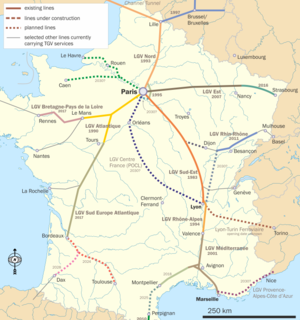|
LGV Méditerranée
The LGV Méditerranée (French: Ligne à Grande Vitesse; English: Mediterranean high-speed line) is a 250-kilometre-long (160-mile) French high-speed rail line running from north to south between Saint-Marcel-lès-Valence, Drôme and Marseille, Bouches-du-Rhône, also featuring a connection to Nîmes, Gard to the west. It connects the regions of Provence-Alpes-Côte d'Azur and Occitanie to the LGV Rhône-Alpes and from there onto Lyon and the north of France. Construction costs rose to €3.8 billion; the line entered service in 2001 following an official opening by President Jacques Chirac. The commencement of service on the line has led to a reversal of the respective airplane and train markets: by making Marseille reachable in three hours from Paris—a distance of over 750 kilometres (470 mi)—the train now handles two-thirds of all journeys on that route. LGVs Méditerranée, Rhône-Alpes and Sud-Est, when completed, also received their official nickname, the City To Coast (C2C) Highway ("Ville à la Mer").[2] The line features the Tunnel de Marseille, allowing it to enter Marseille underground, the longest railway tunnel wholly located in France, at 7.8 km (4.8 mi).[3] RouteThe LGV Méditerranée begins in the southeast at Saint-Marcel-lès-Valence, as the extension of the LGV Rhône-Alpes. The new Valence TGV station lies at the interchange with the regular Valence–Grenoble line, allowing rapid connections towards Valence, Romans-sur-Isère and Grenoble. At Crest, an emergency link is provided to the Briançon–Loriol line. The LGV then approaches the Rhône, rejoining the A7 autoroute at Montélimar. After crossing the Canal de Donzère-Mondragon, the line connects to the regular network by an emergency link situated between Pierrelatte and Lapalud. Spanning the Rhône three times (twice at Mornas, once north of Roquemaure), the LGV continues to Les Angles, where a triangle allows access to the southwest and southeast. The southwest branch is generally thought of as the beginning of a future LGV Languedoc-Roussillon, joining the regular Avignon–Nîmes line 25 kilometres (16 mi) later at Redessan and since 2017 the LGV Nîmes–Montpellier. The southeast branch crosses the Rhône again on two parallel viaducts and serves the new Avignon TGV station, then follows the Durance which it crosses at Orgon. At Ventabren, a 1.73 kilometres (1.07 mi) viaduct extends across the A8 autoroute, the D10 and the Canal de Provence. The line then dives southward, serving the new Aix-en-Provence TGV station, traverses the 8 kilometres (5.0 mi) long Tunnel de Marseille and re-joins the regular network at the entry to Marseille. Stations
Controversy
Journey timesFrom Paris
Interregional
See alsoReferences
External links |
||||||||||||||||||||||||||||||||||||||||||||||||||||||||||||||||||||||||||||||||||||||||||||||||||||||||||||||||||||||||||||||||||||||||||||||||||||||||||||||||||||||||||||||||||||||||||||||||||||||||||||||||||||||||||||||||||||||||||||||||||||||||||||||||||||||||||||||||||||||||||||||
Portal di Ensiklopedia Dunia
